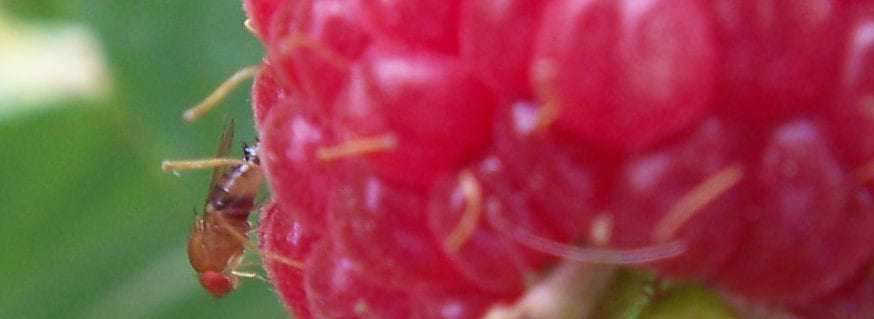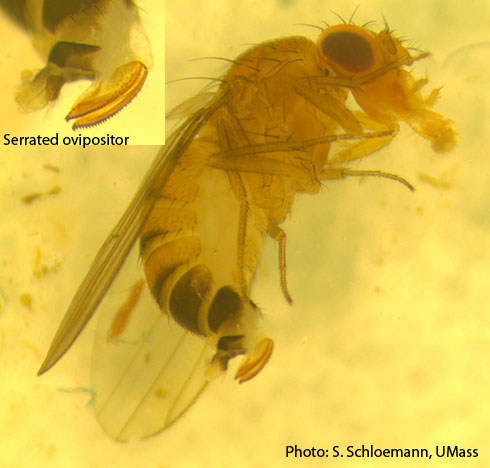The 2015 trapping season is underway and first detection of SWD has occurred in Ontario, Canada and New York State. This is certainly earlier than in 2014! It is also the earliest trap catch reported for New York since this invasive arrived here in 2012. Typically, a single trap (out of four) is catching a single female, indicating counts are low. Eggs laid by those females will become adults in about a week's time.
Low trap catch counts are a good alert for you to get ready to protect your crops. We have updated the quick reference tables for insecticides for berries, tree fruit and grapes. Step up fruit monitoring in your June strawberry fields. Be vigilant of your summer raspberry plantings and know when ripe fruit are developing. Consider protecting sweet cherry and tart cherry with an insecticide targeted at SWD in your treatment program. Keep tabs on reports from your county from our monitoring network via the SWD blog.
In NY, first catch was reported from one research site in the Finger Lakes—a single female SWD in a trap on the edge of a summer raspberry planting in Schuyler County, NY—using a commercially available Sentry lure with unscented soapy water as the drowning solution. New this season, I'll be reporting research findings comparing different lures for trapping SWD from Long Island, the Hudson Valley, and the Finger Lakes regions of NY. These reports aren't included on the NY distribution map.
In Ontario, Canada they have found low numbers of flies at sites in Essex, Norfolk, Oxford, and Halton counties and the Niagara and Durham region; three of the sites were in blueberry plantings. This is about three weeks earlier than normal for Ontario Province. On their ONfruit blog is an excellent photograph of what an infested strawberry will look like—note the sunken spot on the fruit surface.

Sixteen cooperators with Cornell Cooperative Extension and the College of Agriculture and Life Sciences will be monitoring approximately 134 traps at 50 locations in 29 Counties in NY (Albany, Cayuga, Chemung, Clinton, Columbia, Dutchess, Erie, Essex, Genesee, Herkimer, Livingston, Monroe, Niagara, Onondaga, Ontario, Orange, Orleans, Rensselaer, Saratoga, Schuyler, Seneca, Steuben, Suffolk, Tioga, Ulster, Washington, Wayne, Wyoming, and Yates). No first catch reports have come in from these sites as of this writing. Our goal is to monitor SWD until first catch and report this on the blog and on the NY SWD distribution map so growers can protect their crops.
Historic look at first catch reports in NY
In 2012, first report by rearing (two week lag time) was on June 27, in June strawberry, Monroe County.
In 2012, first catch was on July 6, in sweet cherry, Yates County.
In 2013, first catch was on June 11 in woods, Ontario County.
In 2014, first catch was on July 9 in raspberry, Suffolk County.
In 2015, first catch was on June 18, in raspberry, Schuyler County.


